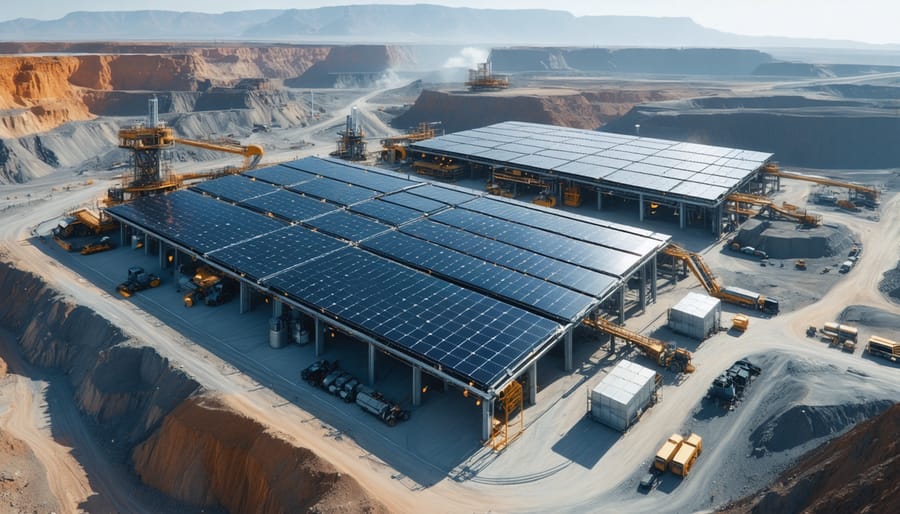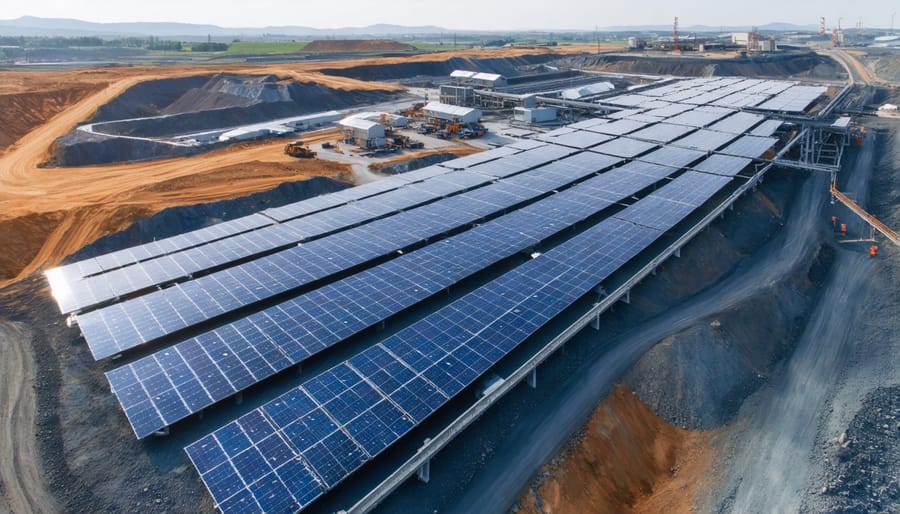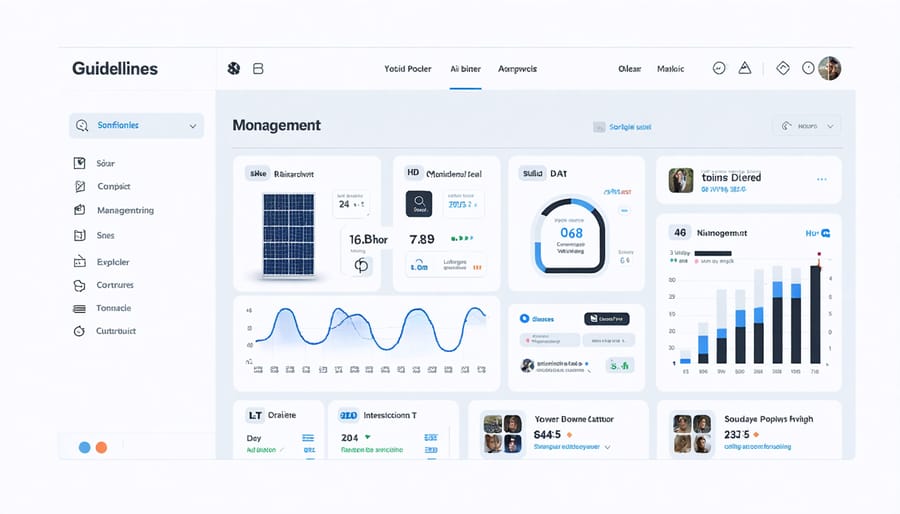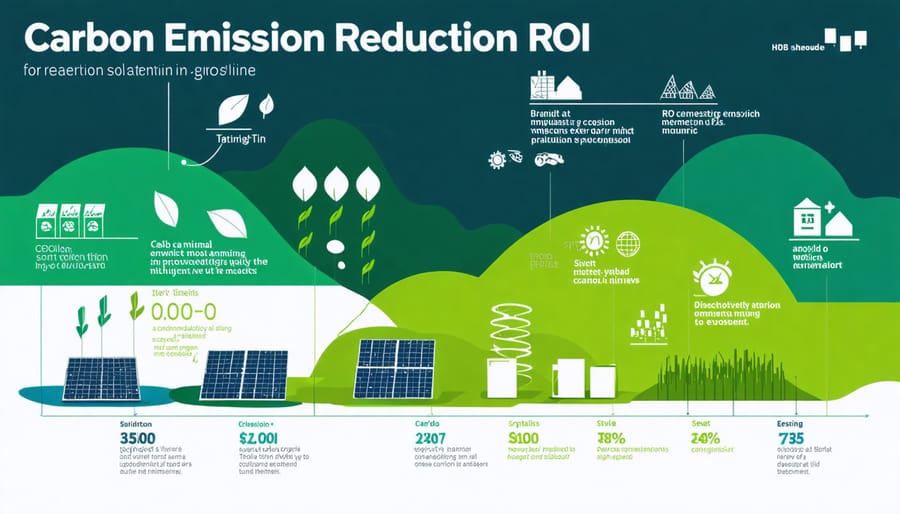Smart Solar Solutions Transform Mining: Latest Tech Driving Efficiency

Advanced solar technologies are rapidly transforming the mining industry through groundbreaking innovations in photovoltaic efficiency and energy storage solutions. The convergence of high-performance bifacial panels, artificial intelligence-driven tracking systems, and advanced energy management platforms has pushed solar conversion rates beyond 24%, marking a significant milestone in industrial energy transformation.
European industries are witnessing unprecedented advances in concentrated solar power (CSP) technologies, with next-generation thermal storage systems enabling 24/7 operations. These developments, coupled with innovative floating solar installations and hybrid power solutions, are revolutionizing how energy-intensive operations approach sustainability and operational efficiency.
The integration of smart grid technologies and advanced monitoring systems has made it possible to optimize solar power generation in real-time, ensuring maximum output even in challenging environmental conditions. This technological evolution represents a crucial step forward in achieving energy independence and meeting ambitious carbon reduction targets across the industrial sector.
As we advance into a new era of sustainable energy solutions, these cutting-edge solar technologies are not just alternatives but essential components of modern industrial infrastructure, offering both environmental benefits and compelling economic advantages.
Solar-Powered Mining Infrastructure
High-Performance PV Systems for Industrial Scale
High-performance photovoltaic systems designed for industrial applications represent a significant advancement in renewable energy solutions for the mining sector. These specialized industrial-scale solar installations are engineered to withstand harsh mining environments while delivering optimal energy output.
These systems typically incorporate robust bifacial panels that capture both direct sunlight and reflected light from surrounding surfaces, increasing energy yield by up to 30% compared to traditional panels. Advanced tracking systems ensure maximum solar exposure throughout the day, while specialized coating technologies protect the panels from dust and mineral residue common in mining operations.
The systems are equipped with smart monitoring capabilities that enable real-time performance tracking and predictive maintenance, ensuring consistent power output and minimal downtime. Sophisticated energy storage solutions, including advanced battery systems, are integrated to maintain power supply during non-peak hours and adverse weather conditions.
European mining operations implementing these systems have reported significant reductions in operational costs and carbon emissions. The modular design allows for scalability, enabling mining companies to expand their solar capacity as needed. Additionally, these systems are designed with enhanced durability features, including reinforced mounting structures and specialized glass treatments, ensuring longevity in challenging industrial environments.

Industrial Energy Storage Solutions
Industrial energy storage has become a cornerstone of advanced solar technology implementation, enabling businesses to maximise their renewable energy investments. Modern battery systems have evolved significantly, offering unprecedented flexibility and reliability for industrial applications.
Leading the charge are lithium-ion battery installations, which have seen dramatic improvements in both capacity and longevity. These systems now routinely deliver 85-90% round-trip efficiency while requiring minimal maintenance. For industrial applications, modular battery configurations ranging from 250kWh to several MWh provide scalable solutions that grow with energy demands.
Flow batteries represent another breakthrough in industrial storage, particularly suitable for long-duration applications. These systems separate power and energy capabilities, allowing for independent scaling of storage capacity. This technology proves especially valuable for industries with variable production schedules or seasonal energy demands.
Thermal energy storage systems complement traditional battery solutions by converting excess solar energy into heat, which can be used for industrial processes or converted back to electricity when needed. These systems achieve remarkable efficiency rates while utilizing more cost-effective materials than chemical batteries.
Smart energy management systems integrate seamlessly with these storage solutions, optimising energy flow based on real-time production data, weather forecasts, and energy prices. This intelligence helps industries reduce peak demand charges while ensuring consistent power supply during production hours.
For European industries, these storage solutions provide crucial grid independence and energy security, while supporting the continent’s ambitious renewable energy targets.
Smart Integration Technologies
Automated Power Management Systems
Automated Power Management Systems represent a significant leap forward in solar energy efficiency, combining artificial intelligence with sophisticated monitoring technologies to optimize energy distribution and consumption. These intelligent systems continuously analyze energy production patterns, weather forecasts, and consumption habits to make real-time adjustments that maximize solar power utilization.
At the heart of these systems lies advanced machine learning algorithms that predict energy demands and automatically adjust power flow to match peak usage times. For European businesses and homeowners, this means smarter energy distribution that can reduce electricity costs by up to 25% while ensuring consistent power supply during varying weather conditions.
The systems incorporate smart inverters and battery storage solutions, creating a seamless integration between solar panels, the power grid, and home or industrial energy systems. Through intuitive user interfaces, owners can monitor performance metrics, receive maintenance alerts, and view detailed analytics about their energy consumption patterns.
One particularly innovative feature is the ability to automatically prioritize power distribution based on predetermined preferences. For instance, during peak production hours, excess energy can be automatically directed to high-consumption appliances or stored in batteries for later use. The system can also intelligently switch between grid power and solar energy based on real-time electricity rates, maximizing cost savings.
For industrial applications, these management systems offer additional capabilities such as load balancing across multiple facilities and integration with existing building management systems. This comprehensive approach ensures optimal energy utilization while maintaining operational efficiency and reducing the carbon footprint of businesses across Europe.

Remote Monitoring and Control
Modern solar installations benefit significantly from sophisticated remote monitoring and control systems, revolutionising how we manage solar energy production. These advanced systems enable real-time performance tracking, predictive maintenance, and instant issue detection, ensuring optimal energy generation and system longevity.
Central to these capabilities are smart inverters and IoT sensors that continuously collect data on power output, environmental conditions, and component health. Facility managers can access this information through user-friendly dashboards on their computers or mobile devices, providing unprecedented visibility into system operations from anywhere in the world.
European solar installations particularly benefit from these technologies, with many facilities implementing AI-driven monitoring solutions that can predict potential issues before they occur. These systems analyse performance patterns and weather data to optimise panel positioning and cleaning schedules, maximising energy yield throughout the year.
Remote control functionality allows operators to adjust system parameters, implement safety protocols, and even isolate specific components when necessary – all without physical intervention. This capability proves especially valuable during extreme weather events or maintenance operations, enabling swift responses to changing conditions.
The integration of smart monitoring systems typically results in:
– Up to 30% reduction in maintenance costs
– Improved system efficiency through data-driven optimisation
– Enhanced safety through immediate fault detection
– Reduced downtime through predictive maintenance
– Better resource allocation for maintenance teams
These monitoring solutions also support compliance with European energy regulations by providing detailed performance records and automated reporting capabilities. As solar technologies continue to advance, remote monitoring systems are becoming increasingly sophisticated, offering enhanced analytics and automation features that make solar energy management more efficient and reliable than ever before.
Environmental Impact and Sustainability
Carbon Footprint Reduction
Advanced solar technologies play a crucial role in reducing carbon emissions across Europe, delivering quantifiable environmental benefits that align with the EU’s climate goals. Recent studies indicate that modern solar installations can offset between 25-30 tonnes of CO2 emissions annually per installed megawatt, depending on the region’s energy mix and solar intensity.
For a typical commercial installation of 100kW, this translates to approximately 85 tonnes of CO2 emissions avoided each year – equivalent to removing 18 passenger vehicles from the road. Industrial-scale solar implementations demonstrate even more impressive results, with some facilities reporting emission reductions of over 10,000 tonnes annually.
The latest bifacial solar panels, combined with smart tracking systems, enhance these benefits by 5-15% compared to traditional installations. In regions like Southern Europe, where solar irradiance is optimal, the impact is particularly significant. For instance, a modern 1MW solar facility in Spain can offset up to 40% more emissions than its decade-old counterparts.
The lifecycle analysis of current solar technologies shows that the carbon payback period has decreased to under two years in most European locations. This rapid return means that solar installations spend over 90% of their operational life actively reducing carbon emissions. When combined with energy storage solutions and smart grid integration, these systems can further optimize their carbon reduction potential by up to 25%.
Sustainable Mining Practices
The integration of solar technology in mining operations represents a significant shift towards sustainable mining practices, revolutionizing how the industry approaches energy consumption and environmental responsibility. Advanced solar installations are increasingly powering critical mining operations, from processing facilities to electromagnetic separation systems, significantly reducing reliance on conventional power sources.
Modern mining operations are implementing hybrid solar solutions that combine photovoltaic arrays with energy storage systems, ensuring consistent power supply during both peak production hours and nighttime operations. These systems are particularly effective in remote mining locations across Europe, where grid connectivity can be challenging and expensive.
The implementation of solar technology in mining has demonstrated remarkable results, with some operations reducing their carbon emissions by up to 30% while achieving substantial cost savings. Innovative tracking systems maximize solar exposure throughout the day, while smart grid integration enables efficient power distribution across various mining processes.
Moreover, solar-powered mining operations are incorporating advanced monitoring systems that optimize energy consumption patterns and predict maintenance needs. This proactive approach not only enhances operational efficiency but also extends the lifespan of mining equipment. The combination of solar technology with digitalization creates a more sustainable and economically viable mining ecosystem, setting new standards for resource extraction in the 21st century.
Implementation and ROI

Cost-Benefit Analysis
The financial implications of advanced solar technologies present compelling returns on investment for European businesses and industries. Initial installation costs typically range from €800 to €1,500 per kW, depending on the system size and complexity. However, through cost-effective solar implementation, organizations can expect to recover their investment within 4-6 years.
Operational savings are particularly significant, with most installations reducing energy costs by 40-60% annually. When factoring in current EU green energy incentives and tax benefits, the net savings can increase by an additional 20-30%. Modern solar systems also demonstrate remarkable durability, with performance warranties extending to 25 years and minimal maintenance requirements averaging just 1% of the initial investment annually.
The long-term financial benefits extend beyond direct energy savings. Enhanced property values, carbon credit trading opportunities, and protection against rising energy costs contribute to a robust ROI. Additionally, businesses implementing advanced solar solutions report improved stakeholder relations and strengthened ESG profiles, delivering both tangible and intangible returns on their solar investments.
Implementation Timeline
The implementation of advanced solar technologies typically follows a structured timeline spanning 6-12 months, depending on project scope and complexity. Initial assessment and planning usually takes 4-6 weeks, during which site surveys, energy consumption analysis, and technical feasibility studies are conducted. This phase ensures optimal system design and positioning for maximum solar capture.
The procurement and preparation phase follows, lasting 8-12 weeks. This includes securing necessary permits, ordering equipment, and coordinating with local utilities. European regulations and grid connection requirements are carefully considered during this stage to ensure compliance and smooth integration.
Installation typically requires 2-4 weeks, with timing often scheduled to minimize operational disruption. Advanced monitoring systems and smart inverters are integrated during this phase, enabling precise performance tracking and remote management capabilities.
The commissioning phase spans 1-2 weeks, including thorough testing, calibration, and system optimization. Post-installation support continues with regular maintenance checks and performance monitoring. Many installations achieve full operational capacity within one week of commissioning, though seasonal variations may affect initial output levels.
Training and handover documentation complete the implementation process, ensuring operators and stakeholders can effectively manage their new solar installation.
Advanced solar technologies are revolutionizing the mining industry, offering a transformative path toward sustainable and efficient operations. The integration of these innovative solutions demonstrates how traditional energy-intensive industries can successfully transition to cleaner, more cost-effective power sources while maintaining operational excellence.
The implementation of solar technologies in mining operations has proven to deliver multiple benefits, from significant reduction in operational costs to enhanced environmental compliance. By embracing these advanced solutions, mining companies are not only reducing their carbon footprint but also securing long-term energy independence and price stability.
European mining operations, in particular, have shown remarkable progress in adopting these technologies, setting new industry standards for sustainability. The successful integration of solar power systems, combined with smart energy management solutions and storage capabilities, has created a blueprint for future mining operations worldwide.
Looking ahead, the continued advancement of solar technologies promises even greater potential for the mining sector. As efficiency levels improve and installation costs decrease, we can expect to see more widespread adoption across the industry. This transformation represents more than just an energy transition – it’s a fundamental shift toward more sustainable, responsible, and profitable mining practices that align with global climate goals while ensuring operational reliability.
The future of mining is increasingly solar-powered, and those who embrace these advanced technologies today will be better positioned to thrive in tomorrow’s energy landscape.
Leave a Reply